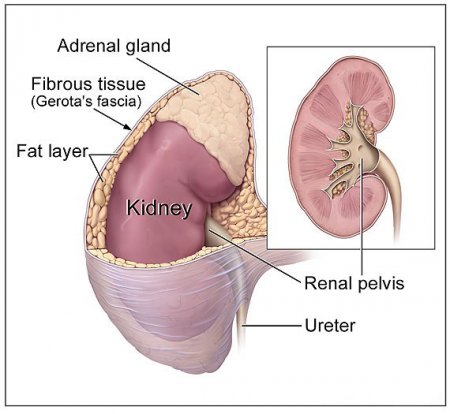Adrenal cancer
- Category: Oncology
- Views: 16623
Tumors of the adrenal gland have recently been encountered more often - due to the wide availability of ultrasound and computer tomography, tumor formation of the adrenal gland is detected in 2-3% of the subjects. There is evidence that a tumor of the adrenal gland can be found by careful examination of 5% of the inhabitants of our planet.
Currently, the situation with the diagnosis and treatment of adrenal tumors resembles the situation with the diagnosis and treatment of thyroid nodules, which was created about 10-15 years ago. At the end of the 20th century, following the widespread use of ultrasound of the thyroid gland, thyroid nodules began to appear in 20-30% of the inhabitants of the Earth, following the number of operations on the thyroid gland it began to grow simply in geometric progression. In some medical centers, there is an almost 10-fold increase in the number of operations on the thyroid gland! Only in regard to all thyroid nodules, only 5% are malignant, and all the rest are completely harmless benign Educations, never "degenerating" into cancer. Currently, the leading specialized centers, and with benign nodes that reduce the patient's quality of life - i.e. They work strictly according to the indications, avoiding operations on all other nodes.
The situation with tumors of the adrenal glands is similar in many respects to the situation with thyroid nodules, only for the adrenal glands the "computer" and magnetic resonance imaging were the "catalyst" for the increase in the number of operations. These studies appeared later than ultrasound, and they are less frequent, so the "wave" of surgery on the adrenal gland also appeared later.
Often, when CT or MRI of the abdominal cavity doctors diagnose radiation accidentally notice the tumor of the adrenal gland. For such randomly detected tumors even came up with a special name - "insidentaloma" (from random - random). It is important to understand that an accidentally detected tumor of the adrenal gland is by no means an occasion for an obligatory operation. A thorough examination is required, in which the diagnosis will be clarified, and there will also be indications for the operation (or it becomes clear that there is no indication for the operation).
Symptoms of adrenal tumors
Symptoms of the disease may be associated with the structure of the tumor (benign or malignant), and with the presence or absence of tumor hormonal activity.
If adrenal tumor malignancy symptoms are typical for all malignant tumors (weight loss, appearance of pain, the appearance of digestive disorders, disorders of vascular function, etc.), hormonal symptoms such tumors depend only on a particular hormone produces swelling (cortisol, aldosterone , Sex hormones, adrenaline, norepinephrine).
Hormonal symptoms of adrenal tumors may include the appearance of obesity, muscular weakness, osteoporosis, depression, stretching the skin (at a cortisol-generating tumor adrenal cortex), krizovoe or persistent increase in arterial pressure (in pheochromocytoma - tumors generating adrenaline, or noradrenaline, with aldosteronoma - tumors, produce aldosterone), development of a number of male sexual characteristics (pronounced musculature, body hair, coarse voice) when virilizuyuschey adrenal adenoma (en Droster), which produces sex hormones.
Fortunately, malignant adrenal tumors (adrenocortical cancer, malignant pheochromocytoma) are rare - 1-2% of all tumors. In most cases, by the time of detection of these tumors are of considerable size (up to 4 cm) and are frequently accompanied by regional metastases (lymph node) or distant metastases (lung, bone). Malignant tumors of the adrenal gland require rapid and radical treatment.
Diagnosis of adrenal tumors
For examination of a patient with suspected adrenal tumor, the following imaging methods are used:
- US of the adrenal glands (safe, cheap and affordable method, its shortcomings are low informative, especially in patients with obesity);
- Computed tomography (optimally - with intravenous injection of contrast medium, which allows to draw conclusions about the structure of the tumor);
- Magnetic resonance imaging.
In some cases radionuclide diagnostic methods can be used:
- adrenal scintigraphy with metaiodobenzylguanidine (MIBG);
- positron emission tomography with 18-FDG.
Among the hormonal studies for tumors of the adrenal glands, the following can be used:
- daily urine analysis for cortisol;
- analysis of daily urine on metanephrine;
- blood test for ACTH, cortisol, chromogranin A, renin, aldosterone, calcitonin, blood ions (potassium, calcium, chlorine, sodium), parathyroid hormone.
The choice of a specific method of examination is determined by an endocrinologist who conducts the diagnosis.
Treatment of adrenal cancer
With some benign tumors of the adrenal gland, treatment may not be required at all. This applies to small non-hormone-producing tumors, for which there is no information about their malignant structure. Such benign tumors of the adrenal glands require only regular examination, periodic repetition of hormonal assays and repeated computer tomography. The prognosis for such tumors is favorable.
If a suspected malignancy is present, the tumor of the adrenal gland requires removal. Surgery for adrenal gland tumors should be performed in a specialized endocrine surgery center, which has sufficient experience in the field of adrenal surgery. Surgery for adrenal gland tumors can be performed both by extremely low-traumatic access (lumbar endoscopic extraperitoneal access) and by traumatic open access, accompanied by the intersection of the muscles of the anterior abdominal wall, chest wall and diaphragm.
